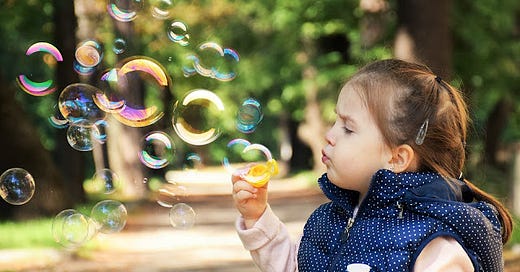"When you go out your backdoor to your backyard, you are not predestined where you want to go. You wanna run where your urges take you" - Neil deGrasse Tyson
Look at the girl in the picture above. What do you see? I see movement. I also see those bubbles as different experiences that came from that little girl's action of free-playing. I call that Organismic Physical Education, or the natural process through which an organism learns to move, interact with, and understand the environment, individually and collectively. It is a constant process that lasts throughout the entire life, from conception to end.
As a little boy, I used to blow bubbles too (and I still do), and as soon as I blew, I would run like crazy to see if I could catch them all. However, every time I tried to get one or two, I would be mesmerized not just by the reflection of the surroundings in the bubble but by the actual surroundings. A stick here, a puddle there, a lizard over there, the sky above, and the ground below. Each time was an adventure that required me to use all of my senses, my previous knowledge about the world and how to move, and my imagination for finding new ways to move and explore.
Based on my childhood experiences and having studied at the university the importance of free play, back when I was a school PE Teacher, I had one day a week where my students had no structured teaching. In fact, they had no teaching at all from my part. I would only give them some general rules like no fighting, or no getting out of the basketball court or soccer field (which were my classrooms) and that was it. I would pull out every single equipment, accessory, toy, or game and they had permission to do whatever they wanted to play, if they wanted.
One day, the most magical thing happened. It was "basketball-court" day, and for some unknown reason, they all wanted to be in it. Not on the bleachers' area, not beyond the outside lines, but inside the lines where the game is played. Some wanted to just talk, some wanted to play basketball, some board games, some soccer, and some wanted to play volleyball. What a conundrum right? All of these activities, about 30 students wanting to play simultaneously, in groups of different sizes, in such a limited space.
After some negotiation and some light argumentation, they divided the court into different portions of different sizes relative to the activities each group wanted to do. One half of the court was divided into those who wanted to play basketball and the ones who wanted to talk and play board games. The other half was divided into those who wanted to play soccer and those who wanted to play volleyball. And you may think, "Wow, that will be total chaos!", but no. It was incredible to see how they created their own ways to take part in each activity without bothering or hurting the others, and so that there was a balance in the force.
At the end of the day, they all had stories of how they had so much fun and how creative they had to be in order to play. They were happy, and they had new experiences, which are extremely essential not just for our kids to grow, but for our society to keep evolving. Most importantly, they survived on their own.




